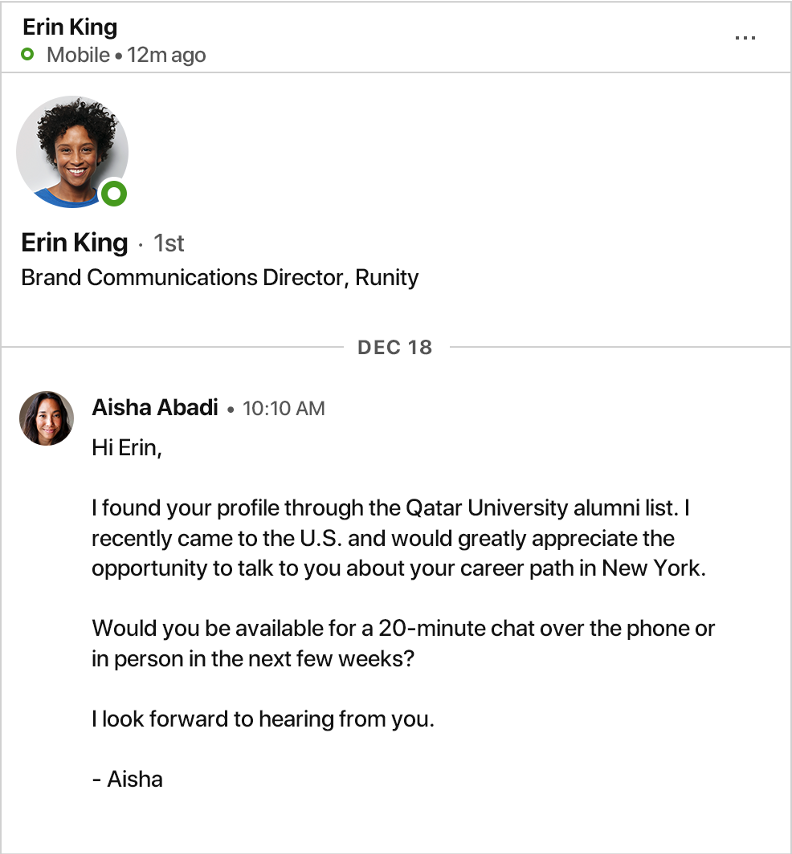How To Create A Strong LinkedIn Profile For Job Hunting In Canada?
If you’re looking to land a job in Canada, having a strong LinkedIn profile is essential. In this article, we’ll explore the key steps to creating a powerful LinkedIn profile that will catch the attention of potential employers. From selecting the right profile picture to optimizing your headline and summary, we’ll guide you through the process of crafting a standout LinkedIn profile that showcases your skills and experience. With our tips, you’ll increase your chances of connecting with employers, networking with professionals, and ultimately, securing your dream job in Canada.

1. Choose a Professional Profile Photo
Ensure your photo is professional and appropriate
When it comes to creating a strong LinkedIn profile for job hunting in Canada, one of the first things you should do is choose a professional profile photo. This photo is the first impression that potential employers and recruiters will have of you, so it’s important to make it count. Make sure your photo is professional and appropriate for the platform. Avoid using selfies or casual photos and opt for a professional headshot instead.
Use a high-quality photo
In addition to choosing a professional photo, it’s crucial to use a high-quality image for your LinkedIn profile. Remember, your photo is a representation of your professionalism and attention to detail. Blurry or pixelated photos can give the wrong impression and make it harder for employers to take you seriously. Invest in a high-quality photo or seek the help of a professional photographer to ensure your picture stands out.
Wear professional attire
When selecting a photo for your LinkedIn profile, always dress in professional attire. This means wearing clothing that is appropriate for the industry you’re targeting or the position you’re seeking. Dressing professionally not only demonstrates that you take your career seriously, but it also helps recruiters and potential employers envision you fitting into their organization.
Select a simple background
Lastly, choose a simple background for your profile photo. This helps keep the focus on you and prevents any distractions from taking away from your professional image. A plain backdrop or a neutral office setting is ideal for creating a clean and polished look. Remember, the goal is to showcase yourself as a professional and make it easy for others to see you in a professional setting.
2. Craft a Compelling Headline
Use keywords relevant to your industry
Your LinkedIn headline is one of the first things people see when they visit your profile, so it’s important to make it compelling and relevant. Use keywords that are pertinent to your industry and the type of job you’re seeking. This can help optimize your profile for search engines and make it easier for recruiters to find you. For example, if you’re in marketing, include keywords like “digital marketing,” “content strategist,” or “social media specialist” in your headline.
Highlight your areas of expertise
In addition to using keywords, make sure to highlight your areas of expertise in your LinkedIn headline. This can give potential employers an immediate insight into your skills and strengths. Whether it’s project management, data analysis, or customer service, showcasing your expertise in your headline can help you stand out from the crowd.
Include your job title and company name
To make your headline even more effective, include your current job title and company name. This can provide context and credibility to your profile, especially if you’re currently working in a reputable organization. It helps potential employers understand your current professional status and can add value to your overall profile.

3. Write an Engaging Summary
Capture attention with a well-crafted opening statement
Your LinkedIn summary is an opportunity to showcase your personality, enthusiasm, and professional background. To capture attention, start with a well-crafted opening statement that immediately grabs the reader’s attention. Use powerful words, share a brief story, or ask thought-provoking questions to engage your audience right from the start.
Highlight your key skills and accomplishments
Once you’ve grabbed the reader’s attention, it’s time to highlight your key skills and accomplishments in your LinkedIn summary. Focus on the strengths that are most relevant to the job you’re pursuing in Canada. Be concise and specific, using bullet points or short paragraphs to make it easy for recruiters and employers to skim through and understand your qualifications.
Show your passion for your field
To create a strong LinkedIn profile, it’s important to show passion for your field in your summary. Express your enthusiasm for the industry you’re in and explain why you’re passionate about the work you do. This can help potential employers see that you’re genuinely interested in the job and are likely to bring dedication and commitment to any role you take on.
Include relevant keywords for search optimization
Lastly, don’t forget to include relevant keywords in your LinkedIn summary. These are the terms that recruiters and employers are likely to search for when looking for candidates. Incorporating keywords into your summary can increase your chances of appearing in relevant search results and improve your overall visibility. Research industry-specific keywords and integrate them naturally into your summary.
4. Showcase Your Work Experience
List your previous job titles and companies
When it comes to showcasing your work experience on LinkedIn, it’s important to list your previous job titles and the companies you’ve worked for. This helps potential employers get a clear picture of your professional background and the level of expertise you bring to the table. Start with your most recent position and work your way backward, including the job titles and companies for each role.
Highlight your responsibilities and achievements
In addition to listing your job titles and companies, make sure to highlight your responsibilities and achievements in each role. Provide concise yet detailed descriptions of the tasks and projects you’ve been responsible for. Focus on the results you’ve achieved, the impact you’ve made, and any notable accomplishments during your tenure. This helps paint a vivid picture of your skills and contributions.
Quantify your accomplishments with numbers or percentages
To make your work experience stand out even more, consider quantifying your accomplishments with numbers or percentages. This adds tangible evidence of your achievements and can help hiring managers gauge the level of your success. For example, instead of saying “increased sales,” say “increased sales by 25% within six months,” or “managed a team of 10 employees.”
Include internships or volunteer experiences
If you have relevant internships or volunteer experiences, don’t hesitate to include them in your LinkedIn profile. Even if they are not traditional paid positions, these experiences can still showcase your skills, dedication, and willingness to contribute to your field. Highlight the relevant responsibilities and achievements from these experiences to demonstrate your commitment to professional growth.

5. Highlight Your Education
List your degrees, certifications, and licenses
Education plays an essential role in your LinkedIn profile, particularly when job hunting in Canada. Make sure to list all the degrees, certifications, and licenses you have obtained. Start with your highest level of education and work your way down. Include the degree or certification obtained, the institution’s name, and the year of completion.
Include the school or institution name and location
In addition to listing your degrees, certifications, and licenses, always include the school or institution name and location. This provides clarity and credibility to your educational background. If you’ve attended multiple schools, include them all to prevent any gaps in your profile. Also, mention any notable affiliations or honors received during your academic journey.
Mention any academic achievements or honors
If you have received any academic achievements or honors during your educational journey, be sure to mention them in your LinkedIn profile. This can include scholarships, dean’s list recognition, or any other notable awards. Highlighting these achievements demonstrates your dedication to excellence and can impress potential employers who value academic success.
6. Add Relevant Skills
Include both hard and soft skills relevant to your desired job
To create a strong LinkedIn profile for job hunting in Canada, it’s crucial to include both hard and soft skills that are relevant to your desired job. Hard skills are specific technical abilities, while soft skills are personal attributes and qualities. Include a well-rounded mix of skills that highlight your expertise and transferable abilities. This can help you appear well-rounded and attractive to potential employers.
Endorse and be endorsed for skills by colleagues and connections
In addition to listing your skills, LinkedIn allows you to receive endorsements from colleagues and connections. Endorsements are a valuable way to validate your skills and add credibility to your profile. Actively endorse others’ skills and ask for endorsements in return. This creates a mutually beneficial network where your skills are reinforced by others, making your profile more robust and trustworthy.

7. Obtain Recommendations
Reach out to former colleagues or supervisors for recommendations
Recommendations are a powerful tool on LinkedIn for building a strong profile. Reach out to former colleagues or supervisors who can provide recommendations for your work ethic, skills, and abilities. Personal recommendations can add a human touch to your profile and provide valuable insights into your professional character. Don’t hesitate to take the initiative and ask for recommendations from individuals who are familiar with your work.
Ask for specific and detailed recommendations
When soliciting recommendations, it’s important to ask for specific and detailed feedback. Instead of generic statements, request that the person highlight specific projects, achievements, or skills that they can attest to. Detailed recommendations carry more weight and provide potential employers with concrete evidence of your capabilities and work ethic.
Recommend others to receive recommendations in return
An effective way to receive recommendations on LinkedIn is to recommend others yourself. By recommending others, you not only demonstrate your willingness to support colleagues but also increase the likelihood of receiving recommendations in return. Mutual recommendations can enhance your professional network and strengthen your overall profile.
8. Join LinkedIn Groups
Find and join industry-specific or job-related groups
To further enhance your LinkedIn profile and expand your professional network, it’s important to join relevant LinkedIn groups. These groups are often industry-specific or job-related and provide opportunities to connect, engage, and gain insights from like-minded professionals. Explore different groups, join those that align with your career goals, and actively participate in discussions.
Participate in group discussions and engage with other members
Joining groups is not enough; active participation is key. Engage with other members by participating in group discussions, posting thoughtful comments, and sharing valuable insights. Taking part in these conversations helps you establish yourself as a knowledgeable and engaged professional within your field. It also provides an opportunity to connect and network with potential employers or colleagues.
Expand your network and gain industry insights
Being part of LinkedIn groups allows you to expand your professional network and gain industry insights. Connect with other group members, engage in conversations, and build relationships. These connections can open doors to potential job opportunities, mentorship, or collaborations. Additionally, becoming an active member of industry-specific groups demonstrates your commitment to continuous learning and professional growth.

9. Use Keywords for Optimization
Research relevant industry keywords and incorporate them in your profile
To optimize your LinkedIn profile for job hunting in Canada, it’s essential to research relevant industry keywords and incorporate them throughout your profile. Keywords are the terms that recruiters and employers are likely to use when searching for candidates. By including these keywords naturally in your headline, summary, job descriptions, and skills sections, you increase your visibility and chances of appearing in relevant search results.
Ensure your profile appears in relevant searches
Strategically using keywords in your profile helps ensure that your LinkedIn profile appears in relevant searches. Recruiters and employers often use specific terms and phrases to find candidates with the desired qualifications. By incorporating these keywords throughout your profile, you increase the likelihood of appearing in their search results, putting you one step closer to landing your dream job.
Optimize your headline, summary, and job descriptions
To make the most impact with your keyword optimization, focus on key areas like your headline, summary, and job descriptions. These sections are highly visible and are often the first things recruiters and employers review. By incorporating relevant keywords, you increase your chances of capturing their attention and standing out from the competition. Remember to use the keywords naturally and in a way that enhances the readability and flow of the content.
10. Regularly Update and Engage
Keep your profile up to date with recent experiences and achievements
A strong LinkedIn profile is one that is regularly updated with recent experiences and achievements. Make it a habit to keep your profile current by adding new roles, projects, or notable accomplishments. This shows potential employers that you are actively engaged in your professional development and are constantly seeking new challenges and opportunities.
Engage with your network by sharing valuable content, commenting, and congratulating others
In addition to updating your profile, it’s important to actively engage with your network on LinkedIn. Share valuable content, industry insights, or relevant articles that showcase your expertise and knowledge. Comment on posts from your connections, congratulate others on their achievements, and connect with individuals who align with your career goals. Building and nurturing your network can lead to valuable connections, job opportunities, and professional growth.
In conclusion, creating a strong LinkedIn profile for job hunting in Canada requires careful attention to detail and thoughtful execution. By following these ten steps – from choosing a professional profile photo to engaging with your network – you can significantly increase your chances of landing your dream job. Remember, LinkedIn is your online professional identity, so it’s crucial to make a strong and lasting impression.







